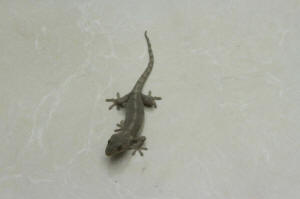|
 Gecko's
amazing wall-walking talent is all in the genes Gecko's
amazing wall-walking talent is all in the genes
 Send a link to a friend
Send a link to a friend
[November 25, 2015]
By Will Dunham
WASHINGTON (Reuters) - Geckos boast one of
the most impressive talents of any animal: the ability to scamper up a
smooth wall or across a ceiling with ease. How do they do it? Well, it
is all in the genes.
|
|
 Scientists on Tuesday said they have sequenced the genome of the
gecko species Gekko japonicus, or Schlegel's Japanese gecko, and
found the genetic underpinning of the lizard's gravity-defying feat. Scientists on Tuesday said they have sequenced the genome of the
gecko species Gekko japonicus, or Schlegel's Japanese gecko, and
found the genetic underpinning of the lizard's gravity-defying feat.
The gecko walks up walls and across ceilings thanks to sophisticated
adhesive foot pads comprised of tiny hairlike structures known as
setae covering the base of its toes. These setae are composed
predominantly of beta-keratin, a protein found in reptiles that is
in the keratin family. Keratin is the substance in human fingernails
and hair.
The scientists found in Gekko japonicus an expansion in the genes
related to beta-keratin, accounting for the gecko's ability to
generate its setae. No such expansion exists in the genomes of other
reptiles lacking the ability to walk on smooth vertical or ceiling
surfaces. All told, 35 such genes were identified.
 "The findings provide a robust genetic basis of adhesive setae
formation," said Xiaosong Gu, a neuroscience and regenerative
medicine researcher at Nantong University in China.
A gecko can cling to nearly any type of surface, whether it is hard,
soft, smooth or rough. The new findings may aid the development of
"bio-inspired adhesive technologies" mimicking the gecko's adhesive
mechanism, Gu added.
Schlegel's Japanese gecko, about 4-1/2 inches (12 cm) long, is a
nocturnal insectivore found in Japan and eastern China. Its climbing
abilities help the gecko catch prey and flee predators.
[to top of second column] |

Gecko foot pads are no recent development. Geckos have existed since
the age of dinosaurs. Scientists in 2008 announced the discovery in
Myanmar of the remains of a gecko with adhesive pads preserved in
amber dating to 100 million years ago.
The study also revealed the genetic foundation of the gecko's sharp
nocturnal vision and its ability to regenerate its tail, Gu said.
Geckos can shed their tail to escape an attacking predator and then
later regenerate it. About 155 genes related to regenerative
abilities were identified, providing fresh insight into regenerative
biology, Gu said.
The size of the gecko's genome was the largest of any reptile
species whose genome has been sequenced, Gu said.
The research was published in the journal Nature Communications.
(Reporting by Will Dunham; Editing by Sandra Maler)
[© 2015 Thomson Reuters. All rights
reserved.]
Copyright 2015 Reuters. All rights reserved. This material may not be published,
broadcast, rewritten or redistributed.
 |